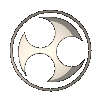
February 23rd, 2014
From
Kyoshi David Baker,Chief Administrator,
Ueshiro Shorin-Ryu Karate USA
founded by Grand Master Ansei Ueshiro
Our targets, selected by the Shinden, are uniquely effective and vulnerable
And precise. “The size of a dime.”
Like
the small, center bull’s-eye of a target at an archery
or rifle range, we also aim at a small bull's-eye, rather
than merely “launching projectiles down-range.”
(We don't always hit the bull's-eye, naturally, but we always
aim for it.) In fact, the human-shaped targets at a range
are of a head and torso, with the "bull's-eye"
in the center of each, which are the same precise targets
as our Jo-dan and Chu-dan targets of nose (brain) and xiphoid
process (solar plexus).
And precision is important because, if we miss the target
with our strike, that’s not only a missed opportunity,
but because our limb is away from our body, we’re now
more vulnerable to a counterstrike from our opponent. We’re
in a worse position than if we hadn’t thrown that missed
technique in the first place.
On the other hand, if we miss the exact bull’s–eye, yet hit our opponent, we can still do damage. Master Ueshiro was a great believer in attacking with full commitment and power. Therefore, a closely missed strike will usually damage the area around the target and may still elicit the desired result.
But
of course the precise target, struck with force, is the
goal of any striking technique. Done properly, one such
strike should, ideally, neutralize our opponent and end
the threat.
There’s a scene in the film The Patriot where the protagonist
instructs his two young sons, while hunting, to “Aim
small. Miss small.” In other words, don’t just
aim anywhere on the body, but choose a small, vital target
and shoot it as accurately as you can.
Visualization can assist as well. In karate, we use certain
mental exercises, often with eyes closed, where we visualize,
or “see” ourselves doing a kata or technique,
without actually doing it physically. This is vital, to
enhance accuracy because, for one thing, we can imagine
perfection, and by imagining perfect technique, we develop
the psychomotor skills inherent in the visualization process
to augment our physical ones. In other words, we can’t
perform perfection, but we can imagine it, and by our visualization
of perfection, stimulate the nerve impulses for correct
technique in our physical kata.
Thirty
years ago, a Black Belt at Hombu conducted an experiment
for his course work at chiropractic college. He had a number
of us thrust the point of a wooden bo through a steel ring,
whose hole was approximately two inches in diameter. We
were then separated randomly into three groups. One practiced
the exercise. One visualized the exercise. And the third
group spent half their time practicing and half visualizing.
After several hours training, over a couple weeks, he then
re-tested the three groups, and the group that had used
visualization only improved the most. The groups were too
small to base any broad conclusions, and the results were
somewhat skewed by one outlier within the visualization-only
group who scored a remarkable six out of six during the
final test, but it was “eye opening” that both
groups that employed visualization improved better than
the practice-only group. This gave evidence that visualization
enhances one’s ability to perform a physical task.
(A theory one can see practiced by just about every Olympic
athlete, visualizing with eyes closed, before each run.)
So, aim at a small, specific target each time. Aim as precisely
as you can. Always improve; never be satisfied with your
results. And use visualization to help burnish, because
“perfect” practice makes for a “perfect”
strike, should you ever need it in a real confrontation.
Domo
arigato gozaimasu,
Kyoshi David Baker,
Chief Administrator,
Ueshiro Shorin-Ryu Karate USA
founded by Grand Master Ansei Ueshiro
under the direction of Hanshi Robert Scaglione
